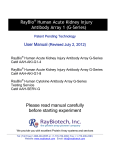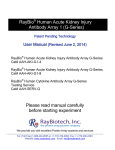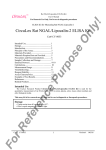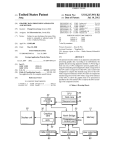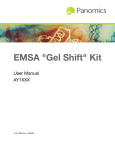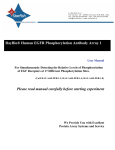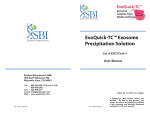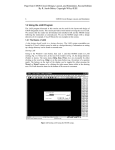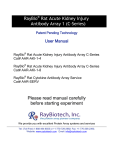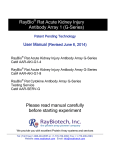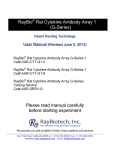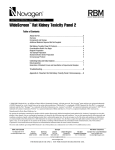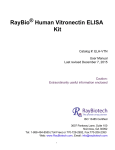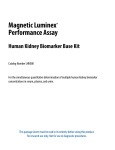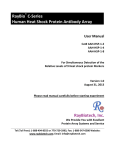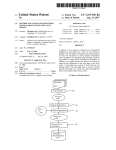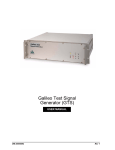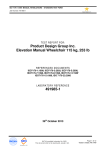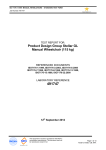Download G Series
Transcript
RayBio® Human Acute Kidney Injury Antibody Array 1 (G Series) Patent Pending Technology User Manual RayBio® Human Acute Kidney Injury Antibody Array G Series Cat# AAH-AKI-G1-4 RayBio® Human Acute Kidney Injury Antibody Array G Series Cat# AAH-TH17-G1-8 RayBio® Human Acute Kidney Injury Antibody Array G Series Testing Services Cat# AAH-SERV-G Please read manual carefully before starting experiment We provide you with excellent Protein Array systems and services Tel: (Toll Free) 1-888-494-8555 or +1-770-729-2992; Fax: +1-770-206-2393; Website: www.raybiotech.com Email: [email protected] RayBio® Human Acute Kidney Injury Antibody Array (G Series) Protocol 0 RayBiotech, Inc., the Protein Array Pioneer Company, strives to research and develop new products to meet demands of the biomedical community. RayBiotech’s patent-pending technology allows detection of up to 507 cytokines, chemokines and other proteins in a single experiment. Our format is simple, sensitive, reliable, reproducible and cost-effective. Our product offerings include: 1. 2. o o 3. 4. 5. 6. o o 7. 8. 9. 10. 11. 12. 13. Protein (antigen) Arrays ® RayBio Cytokine Antibody Arrays C Series (Membrane, chemiluminescence detection) G Series (Glass chip, fluorescence detection) Pathway- and disease-focused antibody arrays o Angiogenesis Antibody Arrays o Apoptosis Antibody Arrays o Atherosclerosis Antibody Arrays o Chemokine Antibody Arrays o Growth Factor Antibody Arrays o Inflammation Antibody Arrays o MMP Antibody Arrays o Obesity Antibody Arrays Quantibody® Multiplex ELISA Arrays ® RayBio L-Series Biotin Label-based Antibody Arrays ® RayBio Phosphorylation Antibody Arrays Receptor Tyrosine Kinases EGFR and ErbB family (site-specific phosphorylation) Over 700 different ELISA kits EIA (Competitive ELISA) kits Cell-based Phosphorylation Assay Over 10,000 different antibodies Recombinant proteins Peptide Recombinant antibodies RayBio® Human Acute Kidney Injury Antibody Array (G Series) Protocol 1 Protocol for RayBio® Human Acute Kidney Injury Antibody Array G Series TABLE OF CONTENTS I. Introduction························································································3 II. Product Information·····································································5 A. Storage Recommendations·······································5 B. Materials Provided····························································6 C. Additional Materials Required·································7 D. How It Works········································································7 E. RayBio® G Series Glass Chip Layout··············8 III. Helpful Tips and General Considerations·················8 A. Preparation and Storage of Samples················8 B. Handling Glass Chips····················································9 C. Incubations and Washes·············································9 D. Data Extraction Tips·····················································10 IV. Protocol······························································································10 A. Preparation and Storage of Reagents·············10 B. Blocking and Incubations··········································12 C. Fluorescence Detection·············································15 V. Interpretation of Results························································15 A. Explanation of Control Spots·································15 B. Typical Results using G Series Arrays···········15 C. Background Subtraction············································16 D. Normalization of Array Data···································16 E. Threshold of Significance··········································18 VI. Antibody Array Maps·······························································19 VII. Troubleshooting Guide··························································20 VIII. Selected References·······························································22 RayBio® Cytokine Antibody Arrays are patent-pending technology. RayBio® is the trademark of RayBiotech, Inc. RayBio® Human Acute Kidney Injury Antibody Array (G Series) Protocol 2 I. Introduction New techniques such as cDNA microarrays have enabled us to analyze global gene expression1-3. However, almost all cell functions are executed by proteins, which cannot be studied simply through DNA and RNA techniques. Experimental analysis clearly shows disparity can exist between the relative expression levels of mRNA and their corresponding proteins4. Therefore, analysis of the proteomic profile is critical. RayBiotech, The Protein Array Pioneer Company, introduced the first protein arrays to the market in 2001 and continues to lead in the development of innovative protein array technologies, such as the RayBio Human Acute Kidney Injury Antibody Array. Acute kidney injury is a common complication among ambulatory and hospitalized patients. It is a rapidly progressive illness that independently predicts excess morbidity and mortality. It is critical to early detect acute kidney injury and distinguish it from prerenal azotemia and chronic kidney disease at the time of patient presentation to rapidly manage associated illness. However, serum creatinine, a standard marker of kidney function, does not distinguish acute kidney injury from prerenal azotemia5 or chronic kidney disease. In addition, the initial measurement of serum creatinine cannot reflect the extent of injury because its accumulation always lags behind the insult6. Concurrently, the potential for improving risk stratification, informing clinical decision making, and guiding pharmaceutical development recently led the American Society of Nephrology to designate the development of novel AKI biomarkers a top research priority7. The response over a few years resulted in the identification of nearly 20 potential markers. Some of the more promising of these include urine or plasma Neutrophil Gelatinase–associated Lipocalin (NGAL)8, Kidney Injury Molecule-1 (KIM-1)9, Cystatin C10, Liver Fatty-acid Binding Protein (L-FABP)11, Monocyte Chemoattractant Protein 1 (MCP-1)12 and Trefoil Factor 3 (TFF3)13. RayBio® Human Acute Kidney Injury Antibody Array (G Series) Protocol 3 Traditionally, urine proteins or cytokines are detected by using ELISA. However, RayBio® Human Acute Kidney Injury Antibody Array G Series can detect 20 protein biomarkers simultaneously with small amount of sample. It is a great tool in the acute kidney injury research areas including drug toxicity monitoring, kidney transplantation rejection reaction monitoring, and kidney injury early detection. 1. Tang X, Marciano DL, Leeman SE, Amar S. LPS induces the interaction of a transcription factor, LPS-induced TNF-a factor, and STAT6(B) with effects on multiple cytokines. PNAS. 2005;102(14): 5132-5137. 2. Xu Y, Kulkosky J, Acheampong E, Nunnari G, Sullivan J, Pomerantz RJ. HIV-1-mediated apoptosis of neuronal cells: Proximal molecular mechanisms of HIV-1-induced encephalopathy. PNAS. 2004;101(18): 7070-7075. 3. El-Hage N, Gurwell JA, Singh IN, Knapp PE, Nath A, Hauser KF. Synergistic increases in intracellular Ca(2+), and the release of MCP-1, RANTES, and IL-6 by astrocytes treated with opiates and HIV-1 Tat. Glia. 2005 Apr 15;50(2):91-106. 4. Oh HS, Moharita A, Potian JG, Whitehead IP, et al. Bone Marrow Stroma Influences Transforming Growth Factor-β Production in Breast Cancer Cells to Regulate c-myc Activation of the Preprotachykinin-I Gene in Breast Cancer Cells. Cancer Res. 2004;64: 6327-6336. 5. Bonventre JV, Weinberg JM. Recent advances in the pathophysiology of ischemic acute renal failure. J Am Soc Nephrol. 2003;14:2199–210. 6. Lameire N, Hoste E. Reflections on the definition, classification, and diagnostic evaluation of acute renal failure [Editorial]. Curr Opin Crit Care. 2004;10:468–75. 7. American Society of Nephrology Renal Research Report. J Am Soc Nephrol. 16: 1886–1903, 2005. 8. Mishra J, Dent C, Tarabishi R, Mitsnefes MM, Ma Q, Kelly C, Ruff SM, Zahedi K, Shao M, Bean J, Mori K, Barasch J, Devarajan P: Neutrophil gelatinase-associated Lipocalin (NGAL) as a biomarker for acute renal injury after cardiac surgery. Lancet . 2005;365: 1231–1238. RayBio® Human Acute Kidney Injury Antibody Array (G Series) Protocol 4 9. Han WK, Bailly V, Abichandani R, Thadhani R, Bonventre JV: Kidney Injury Molecule-1(KIM-1): A novel biomarker for human renal proximal tubule injury. Kidney Intl. 62: 237–244, 2002. 10. Herget-Rosenthal S, Marggraf G, Husing J, Goring F, Pietruck F, Janssen O, Philipp T, Kribben A: Early detection of acute renal failure by serum cystatin C. Kidney Intl. 66: 1115–1122, 2004. 11. Yamamoto T, Noiri E, Ono Y, Doi K, Negishi K, Kamijo A, Kimura K, Fujita T, Kinukawa T, Taniguchi H, Nakamura K, Goto M, Shinozaki N, Ohshima S, Sugaya T: Renal L-type fatty acid–binding protein in acute ischemic injury. J Am Soc Nephrol.18: 2894–2902, 2007. 12. Munshi R, Johnson A, Siew ED, Ikizler TA, Ware LB, Wurfel MM, Himmelfarb J, Zager RA. MCP-1 gene activation marks acute kidney injury. J Am Soc Nephrol. 2011 Jan;22(1):165-75. 13. Yu Y, Jin H, Holder D, Ozer JS, Villarreal S, Shughrue P, Shi S, Figueroa DJ, Clouse H, Su M, Muniappa N, Troth SP, Bailey W, Seng J, Aslamkhan AG, Thudium D, Sistare FD, Gerhold DL. Urinary biomarkers trefoil factor 3 and albumin enable early detection of kidney tubular injury. Nat Biotechnol. 2010 May; 28(5):470-7. II. Product Information A. Storage Recommendations: For best results, we recommend storing the entire kit at –20°C or –80°C upon arrival and using the kit within 6 months of receipt. RayBiotech warranties this product for 6 months if stored in this manner. Once thawed, store glass chips and 2X Blocking Buffer at –20°C or –80°C and all other component at 4°C. After thawing, the entire kit should be used within 3 months. RayBio® Antibody Array kits are robust and will retain full activity even if accidentally stored at room temperature (RT) for up to 24 hours. RayBio® Human Acute Kidney Injury Antibody Array (G Series) Protocol 5 B. Materials Provided Item Description AAH-AKI1-GX AAHTH17G1-4 AAHTH17G1-8 RayBio® Human Acute Kidney 1 chip with 1 chip with Injury Antibody Microarray Glass 4 Sub8 SubChip* arrays* arrays* 0103002-HAK- Biotin-Conjugated Anti-Cytokines 1 ea 2 ea 0103004-H 1,500X HiLyte Plus™ 532 Streptavidin-Fluor† 1 ea 1 ea 0103004-B 2X Blocking Buffer 10 mL 10 mL 0103004-W‡ 20X Wash Buffer I ‡ 30 mL 30 mL 0103004-W‡ 20X Wash Buffer II ‡ 30 mL 30 mL 0103004-L 2X Cell Lysis Buffer (optional) 10 mL 20 mL Other Kit Components: Manual, Adhesive Plastic Strips, 30 mLCentrifuge Tube * Kit contains 1 pre-assembled glass chip with either 4 or 8 printed sub-arrays per chip (in sealed plastic envelope) [NOTE: In some cases, 2 chips x 4 sub-arrays/chip may be substituted in kits containing 8 sub-arrays] † This fluor is patent-pending technology from Anaspec, Inc. ‡ Wash Buffers are sold as sets X = 4 or 8, based on the number of printed sub-arrays on the chip RayBio® Human Acute Kidney Injury Antibody Array (G Series) Protocol 6 C. Additional Materials Required • • • • • • Small plastic boxes or containers Pipettors, pipette tips and other common lab consumables Orbital shaker or oscillating rocker Aluminum foil Wash bottle Gene microarray scanner or similar laser fluorescence scanner D. How It Works Array support Samples Incubation of Sample with arrayed antibody supports 1-2 hrs Cocktail of Biotin-Ab Incubation with Biotinylated Ab 1-2 hrs Labeledstreptavidin Incubation with labeled-Streptavidin 1 hrs Detection of signals Data analysis and graph RayBio® Human Acute Kidney Injury Antibody Array (G Series) Protocol 7 E. RayBio® G Series Glass Chip Layout Antibody Array Antibody Array Blank Blank Barcode Barcode 4 arrays in one glass chip 8 arrays in one glass chip III. Helpful Tips and General Considerations A. Preparation and Storage of Samples 1. General Considerations: • Freeze samples as soon as possible after collection. • Avoid multiple freeze-thaw cycles. If possible, sub-aliquot your samples prior to initial storage. • Spin samples hard (5-10 minutes at 10K to 15K RPM) immediately prior to incubation of samples with array. • Optimal sample concentrations may need to be determined empirically based on the signal intensities of spots and background signals obtained. • Most samples will not need to be concentrated. If concentration is required, we recommend using a spincolumn concentrator with a chilled centrifuge. 2. Recommended Sample Volumes and Dilution Factors NOTE: All sample dilutions should be made using 1X Blocking Buffer. For all sample types, final sample volume = 50-100 μL per sub-array RayBio® Human Acute Kidney Injury Antibody Array (G Series) Protocol 8 • Urine 2-fold to 5-fold dilution Note: The RayBio® Acute Kidney Injury Antibody Array is intended for use with human urine samples. However, if you wish, you may test other sample types as follows: • Serum & Plasma: 2-fold to 5-fold dilution 3. Preparing Urine: • Prepare 500 μL aliquots and store at –20°C or –80°C as soon as possible after collecting urine samples. • Addition of protease inhibitors is not required. • Immediately prior to sample incubation (Step 3 of protocol), spin samples at 1000 rpm for 10 minutes to remove particulates and precipitants. 4. Preparing Serum/Plasma: • Prepare samples according to established protocols or collection tube manufacturer’s instructions. Sub-aliquot into plastic tubes. Store at –20°C or –80°C. • We do not recommend comparing results between serum and plasma samples or between plasma prepared using different anticoagulants. • You may test plasma samples prepared using any anticoagulant (i.e., Heparin, EDTA or Citrate). However, EDTA-prepared plasma may interfere with optimal detection of MMPs and other metal-binding proteins. • If possible, avoid testing hemolyzed serum or plasma, as these samples may generate anomalous cytokine expression patterns and/or high background signals. B. Handling Glass Chips • Do not remove glass chip from assembly until Step 16. • Hold the slides by edges only; do not touch the surface. • Handle all buffers and slides with powder-free gloves. • Dry glass chip completely before proceeding to Step 3. • Handle and dry glass chip in clean environment. RayBio® Human Acute Kidney Injury Antibody Array (G Series) Protocol 9 • Avoid breaking glass chip when removing the chamber assembly. C. Incubations and Washes • Cover incubation chamber with adhesive film (included in kit) to prevent evaporation, particularly during incubation or wash steps >2 h or with liquid volumes <100 μL per well. • Perform all incubation and wash steps under gentle rotation or rocking motion (~0.5 to 1 cycle/s). • Wash steps in Wash Buffer II and all incubation steps may be performed overnight at 4°C. • Overnight sample incubations are the most effective at increasing sample spot intensities. • Avoid cross-contamination of samples to neighboring wells • To remove Wash Buffers and other reagents from chamber wells, you may invert the Incubation Chamber Assembly to decant, and aspirate the remaining liquid. • In Wash Steps 6, 12 and 15, you may gently flush wells several times using a wash bottle filled with Wash Buffer I. D. Scanning and Data Extraction Tips: For tips on scanning and data extraction, please visit our Website: http://www.raybiotech.com/Tech-Support/ScanningTips.pdf For a list of recommended scanners, please visit our Website: http://www.raybiotech.com/resources.asp. IV. Protocol A. Preparation and Storage of Reagents NOTE: During this protocol, prepare reagents immediately prior to use and keep working dilutions of all reagents on ice at all times. 1. Blocking Buffer (Item# 0103004-B) is supplied as 2X. a). For glass chips with 4 sub-arrays each, prepare at least 2.5 ml (1.25 mL 2X Blocking Buffer + 1.25 mL deionized H20). RayBio® Human Acute Kidney Injury Antibody Array (G Series) Protocol 10 b). For glass chips with 8 sub-arrays each, prepare at least 3.0 ml (1.5 mL 2X Blocking Buffer + 1.5 mL deionized H20). c). If your samples require dilution prior to incubation with the sub-arrays, increase this volume accordingly. d). Store 1X and 2X Blocking Buffer at –20°C or –80°C when not in use. 2. Wash Buffers I and II (Item# 0103004-W) are supplied as 20X. a). For each glass chip (4 or 8 sub-arrays/chip), dilute 5 mL of 20X concentrate with deionized H20 to a final volume of 100 mL each of Wash Buffer I & Wash Buffer II. b). Wash Buffer reagents at 1X can be stored at 4°C for up to 1 month. Stock solutions at 20X can be stored 4°C for up to 3 months. 3. Biotin-conjugated Anti-Cytokines are supplied as a small liquid bead (typically ~2-5 μL) of highly concentrated antibodies. a). Spin down the tube prior to reconstitution, as the concentrated liquid bead may have moved to the top of the tube during handling. b). Prepare stock reagent by adding 300 μL 1X Blocking Buffer to Biotin-Conjugated Anti-Cytokines. Mix well. c). 1X Biotin-Conjugated Anti-Cytokines may be stored for 23 days at 4°C. 4. Streptavidin-Fluor is supplied as 1500X. a). Mix the tube containing 1500X Streptavidin-Fluor well before use, as precipitants may form during storage. b). Add 100 μL of 1X Blocking Buffer to tube containing 1500X Streptavidin-Fluor. Mix well. c). Quantitatively transfer all of Streptavidin-Fluor reagent from the original tube to a larger one, and dilute with 1X Blocking Buffer to a final volume of 1500 μL (i.e., 1.5 mL). d). This working dilution can be stored for 3-5 days at 4°C. RayBio® Human Acute Kidney Injury Antibody Array (G Series) Protocol 11 B. Blocking and Incubations NOTE: Please carefully read Section III of this manual before proceeding NOTE: Prepare all reagents immediately prior to use as described above (Section IV.A) before proceeding. 1) Remove the package containing the Glass Chip Assembly from the freezer. Place unopened package on the benchtop and allow the it to equilibrate to room temperature (RT), approx. 15 min. Open package, remove the glass chip assembly and place in laminar flow hood to dry for 1-2 hours. NOTE: Be sure glass chip is completely dry before proceeding. 2) If necessary, assemble the glass chip into Incubation Chamber and frame as shown on pages 12-13. (Note: if you slide is already assembled, you can proceed directly to Step 3). 3) Add 100 μL 1 X Blocking Buffer into each well and incubate at RT for 30 min to block array surface. NOTE: Only add reagents or samples to wells printed with antibodies (see diagram on page 7) RayBio® Human Acute Kidney Injury Antibody Array (G Series) Protocol 12 4) Decant Blocking Buffer; then aspirate remaining liquid. NOTE: To aspirate liquid samples or reagents from wells, gently place the pipette tip only in the corners of the well. Do not scrape the pipette tip across the surface of the chip. 5) Add 50 to 100 μL of each sample to each sub-array. Cover the incubation chamber with Adhesive Film (included in kit). Incubate arrays with sample at RT for 1 to 2 hours with gentle rocking or shaking. Dilute sample using 1X Blocking Buffer if necessary. 6) Remove adhesive film, and carefully aspirate samples from sub-arrays, touching only the corners with your pipette tip. RayBio® Human Acute Kidney Injury Antibody Array (G Series) Protocol 13 7) Wash each array 3 times, 2 min per wash with 150 μL 1X Wash Buffer I at RT. Be sure to completely remove sample and Wash Buffer each time and use fresh buffer for each wash. Decant final wash solution before proceeding to next step. NOTE: Try to prevent solution from flowing into neighboring wells. 8) Obtain a clean container (e.g., pipette tip box or slide staining jar) and place Glass Chip Assembly into the container. Add enough 1X Wash Buffer I to submerge the entire glass chip with frame intact (approx. 30-50 ml) and remove all bubbles in wells. Wash 10 min at RT with gentle rocking or shaking. 9) Remove Glass Chip Assembly and invert it to decant liquid. Decant buffer from container and replenish with 1X Wash Buffer. Again submerge the entire glass chip assembly, and wash 10 min at RT with gentle rocking or shaking. 10) Remove Glass Chip Assembly and invert to decant liquid. Decant buffer from container and repeat Steps 8 & 9 with 1X Wash Buffer II. 11) Invert Glass Chip Assembly to decant liquid, then carefully aspirate wash buffer from wells, touching only the corners with your pipette tip. 12) Add 70 μL of 1X Biotin-conjugated Anti-Cytokines to each subarray. Cover Incubation Chamber with Adhesive Film. Incubate at RT for 2 hours with gentle rocking or shaking. 13) Carefully aspirate Biotin-conjugated Anti-Cytokine reagent. Wash as described in Step 7 above, first with 1X Wash Buffer I then with 1X Wash Buffer II, making sure to completely remove buffer between washes and after final wash. 14) Add 70 μL of 1X Streptavidin-Fluor to each sub-array. Cover the incubation chamber with Adhesive film, then cover entire assembly with aluminum foil to avoid exposure to light or RayBio® Human Acute Kidney Injury Antibody Array (G Series) Protocol 14 incubate in dark room. Incubate at RT for 2 hours with gentle rocking or shaking. 15) Remove aluminum foil and Adhesive Film. Carefully aspirate Streptavidin-Fluor reagent. Wash as described in Step 7 above, first with 1X Wash Buffer I then with 1X Wash Buffer II, making sure to completely remove buffer between washes and after final wash. 16) Remove glass chip from the frame assembly. Place the chip in 30 mL Centrifuge Tube (provided in kit), or slide staining jar. Add enough 1X Wash Buffer I to cover the whole slide (about 20 mL) and gently rock or shake at RT for 10 min. 17) Decant buffer and repeat wash as described in Step 16, this time using 1X Wash Buffer II. Decant buffer, remove the glass chip from the tube, then gently rinse the slide with distilled H2O using a plastic wash bottle. 18) Remove excess liquid from 30 mL Centrifuge Tube and place glass chip into the tube. Centrifuge at 1,000 RPM for 3 minutes to remove water droplets. C. Obtaining Fluorescent Signal Intensities: 19) Remove chip from tube and allow glass chip to dry in a laminar flow hood for at least 20 minutes. Place chip under an aluminum foil tent to protect it from light. Make sure the slides are completely dry before scanning or storage. 20) You may proceed immediately to scanning (Step 21), or you may store the slide at -20 °C in the centrifuge tube provided or at RT and to scan at a later time. Note: Unlike most Cy3 fluors, the HiLyte Plus™ Fluor 532 used in this kit is very stable at RT and resistant to photobleaching on completed glass chips. However, please protect glass chips from strong light and temperatures above RT. RayBio® Human Acute Kidney Injury Antibody Array (G Series) Protocol 15 21) Scan the glass chip with a laser scanner (such as Axon GenePix) using Cy3 or “green” channel (excitation frequency = 532 nm). For tips on scanning, visit our Website: http://www.raybiotech.com/Tech-Support/ScanningTips.pdf NOTE: If you do not have a laser scanner, RayBiotech offers scanning and data extraction services for a nominal fee. Also, using alternate protocols, RayBio® G Series arrays are compatible with Li-Cor’s Odyssey and Gentel BioScience’s APiX scanners. For more information, contact RayBiotech. V. Interpretation of Results: A. Explanation of Controls Spots Positive Controls (POS1, POS2, POS3) are equal amounts of biotinylated IgGs printed directly onto the array. All other variables being equal, the Positive Control intensities will be the same for each sub-array This allows for normalization based upon the relative fluorescence signal responses to a known control, much as “housekeeping” genes or proteins are used to normalize results in PCR or Western blots, respectively. Negative Control (NEG) spots are a protein-containing buffer (used to dilute antibodies printed on the array). Their signal intensities represent non-specific binding of Biotin-conjugated anti-Cytokines and/or Steptavidin-Fluor. Negative control signal intensities are usually very close to background signals in each sub-array. B. Typical results obtained with RayBio® G Series Antibody Arrays The following figure shows typical results obtained using RayBio® G Series Antibody Arrays. The images were captured using a GenePix 4000B scanner. RayBio® Human Acute Kidney Injury Antibody Array (G Series) Protocol 16 Sera from several patients were incubated with Human Cytokine Arrays 6, 7 & 8, (sold together as Human Cytokine Array G Series 2000, AAH-CYT-G2000-4 or AAH-CTY-G2000-8) and processed using this standard protocol. Note the 6 strong signals of the Positive Control spots in the upper-left corner. These spots are useful for proper orientation of the array image. If scanned using optimal scan settings, 3 distinct Positive Control signal intensities will be seen: POS1>POS2>POS3. If all of these signals are of similar intensity, try increasing or decreasing laser power and/or signal gain settings. Once you have obtained fluorescence intensity data, you should subtract the background and normalize to the Positive Control signals before proceeding to analysis. C. Background Subtraction: Most laser fluorescence scanner software have an option to automatically measure the local background around each spot. As RayBio® Human Acute Kidney Injury Antibody Array (G Series) Protocol 17 with spot signal intensities, we recommend using MEDIAN background signals. If your resulting fluorescence signal intensity reports do not include these values (eg, a column labeled as “MED532-B532”), you may need to subtract the background manually or change the default settings on your scanner’s data report menu. D. Normalization of Array Data: To normalize signal intensity data, one sub-array is defined as "reference" to which the other arrays are normalized. This choice can be arbitrary. For example, in our Analysis Tool Software, the array represented by data entered in the left-most column each worksheet is the default “reference array.” You can calculate the normalized values as follows: X(Ny) = X(y) * P1/P(y) Where: P1 = mean signal intensity of POS spots on reference array P(y) = mean signal intensity of POS spots on Array "y" X(y) = mean signal intensity for spot "X" on Array "y" X(Ny)= normalized signal intensity for spot "X" on Array "y" The RayBio® Analysis Tool software is available for use with data obtained using RayBio® G Series Arrays. You can copy and paste your signal intensity data (with and without background) into the Analysis Tool, and it will automatically normalize signal intensities to the Positive Controls. To order the Analysis Tool, please contact us at +1-770-729-2992 or [email protected] for more information. E. Threshold of significant difference in expression: RayBio® Human Acute Kidney Injury Antibody Array (G Series) Protocol 18 After subtracting background signals and normalization to Positive controls, comparison of signal intensities for antigen-specific antibody spots between and among array images can be used to determine relative differences in expression levels of each analyte (ie, protein detected) between samples or groups. Any ≥1.5-fold increase or ≤0.65-fold decrease in signal intensity for a single analyte between samples or groups may be considered a measurable and significant difference in expression, provided that both sets of signals are well above background (Mean background + 2 standard deviations, accuracy ≈ 95%). NOTE: In the absence of an external standard curve for each analyte, there is no means of assessing absolute or relative concentrations of different analytes in the same sample using immunoassays. If you wish to obtain quantitative data (ie, concentrations of the various analytes in your samples), try using our Quantibody® Multiplex ELISA arrays instead. RayBio® Human Acute Kidney Injury Antibody Array (G Series) Protocol 19 VI. RayBio® Human Acute Kidney Injury Antibody Array G Series Map: Detects 20 cytokines in one experiment 1 2 3 4 5 6 7 8 A POS POS B2M B2M IP-10 IP-10 NEG NEG B POS POS Clusterin Clusterin Cystatin C Cystatin C NEG NEG C NEG D NEG NEG NEG CXCL16 GPNMB CXCL16 GPNMB HGF MIF HGF MIF NEG NEG NEG NEG E KIM-1 F ALB G OPN H TFF3 KIM-1 L-FABP L-FABP NGAL NGAL NEG NEG ALB MCP-1 MCP-1 TIMP-1 TIMP-1 NEG NEG OPN sTNFRI sTNFRI VCAM-1 VCAM-1 NEG NEG TFF3 Calbindin-1 Calbindin-1 VEGF VEGF POS POS Abbreviations: POS = Positive Control, NEG = Negative Control, KIM-1 = Kidney Injury Molecule-1, ALB = Albumin, B2M = β2-Microglobulin, OPN = Osteopontin, L-FABP = Liver Fatty-Acid Binding Protein, HGF = Hepatocyte Growth Factor, MIF = Macrophage migration Inhibitory Factor, NGAL= Neutrophil GelatinaseAssociated Lipocalin (Lipocalin 2). All others use standard abbreviations. RayBio® Human Acute Kidney Injury Antibody Array (G Series) Protocol 20 VII. Troubleshooting guide Problem Cause Recommendation No signal for any spots, including Positive Controls Global detection failure Adjust scanner settings or reassemble chip into holder, wash slide 2 x 5 min with 150 μL Wash Buffer II and repeat Steps 12-19. Similar signal intensities for POS1/2/3 Improper laser power and/or PMT setting Repeat scan using higher and/or lower laser power or PMT settings Incomplete washes Carefully follow wash protocols, and/or increase wash times High background signals Sample concentration is Repeat using lower sample too high concentration Fluor and/or AntiCytokines are too concentrated Review protocol for dilution of reagents Bubbles present on chip Be sure to completely remove during incubations all bubbles from chip surface Uneven background and/or missing spots Randomly scattered highintensity spots Evaporation during incubation steps Cover chamber assembly during washes and incubations Pooling/precipitation of sample or reagent; Incomplete washes. Cover chamber assembly and use a rocker or shaker during washes and incubations; carefully follow wash protocols. Sample is too concentrated Repeat experiment using more dilute sample Dust or other particulates Dry slides in laminar flow hood and/or use clean containers and powder-free gloves. RayBio® Human Acute Kidney Injury Antibody Array (G Series) Protocol 21 Sample is too dilute Repeat experiment using higher sample concentration Improper dilution of Anti-Cytokines or StreptavidinFluor Re-assemble chip into holder, wash 2 x 5 min with 150 μL Wash Buffer II and repeat Steps 12-19. Spin down reagents before diluting and mix well. Rescan at higher laser power or signal gain setting Weak or no signals antigen-specific spots + Low Background Repeat using higher sample concentration and/or incubate with sample O/N at 4°C Other Tips Increase concentration of and/or length of incubation with Biotinconjugated Anti-Cytokine (+ addl’l large volume wash following Biotin-Ab incubation Review proper storage conditions for kit components RayBio® Human Acute Kidney Injury Antibody Array (G Series) Protocol 22 III. Selected References Citing RayBio® Human G-Series Arrays 1. Kocaoemer A, Kern S, Kluter H, Bieback K. Human AB Serum and Thrombin-Activated Platelet-Rich Plasma Are Suitable Alternatives to Fetal Calf Serum for the Expansion of Mesenchymal Stem Cells from Adipose Tissue. Stem Cells. 2007; 25:1270-1278 2. Ye Z, Lich JD, Moore CB, Duncan JA, Williams KL, Ting JP-Y. ATP Binding by Monarch-1/NLRP12 Is Critical for Its Inhibitory Function. Mol Cell Biol. 2008; 28:1841-1850.. 3. Sommer G, Kralisch S,Stangl V, Vietzke A, et al. Secretory products from human adipocytes stimulate proinflammatory cytokine secretion from human endothelial cells. J Cell Biochem. 2009; 106(4):729–737. 4. Bouazza B, Kratassiouk G, Gjata B, Perie S, et al. Analysis of growth factor expression in affected and unaffected muscles of oculo-pharyngeal muscular dystrophy (OPMD) patients: A pilot study. Neuromusc Disorders. 2009; 19(3):199-206. 5. Dumortier J, Streblow DN, Moses AV, Jacobs JM, et al. Human Cytomegalovirus Secretome Contains Factors That Induce Angiogenesis and Wound Healing. J Virol. 2008; 82(13):6524655. 6. Keren Z, Braun-Moscovici Y, Markovits D, Rozin A, Nahir M, et al. Depletion of B lymphocytes in rheumatoid arthritis patients modifies IL-8-anti-IL-8 autoantibody network. Clin Immunol. 2009. doi:10.1016/j.clim.2009.07.001 7. Rovin BH, Song H, Hebert LA, Nadasdy T, et al. Plasma, urine, and renal expression of adiponectin in human systemic lupus erythematosus. Kidney Int. 2005; 68:1825-1833. RayBio® Human Acute Kidney Injury Antibody Array (G Series) Protocol 23 8. Duncan JA, Gao X, Huang MT-H, O'Connor BP, Thomas CE, et al. Neisseria gonorrhoeae Activates the Proteinase Cathepsin B to Mediate the Signaling Activities of the NLRP3 and ASCContaining Inflammasome. J Immunol. 2009; 182:6460-6469. 9. Pukstadad BS, Ryana L, Floa TH, JStenvika J, et al. Nonhealing is associated with persistent stimulation of the innate immune response in chronic venous leg ulcers. J Dermatol Sci. 2009; 59(2): 115-122. 10. Park JE, Tan HS, Datta A, Lai RC, et al. Hypoxic Tumor Cell Modulates Its Microenvironment to Enhance Angiogenic and Metastatic Potential by Secretion of Proteins and Exosomes. Mol Cell Proteom. 201; 9:1085-1099. 11. Streblow DN, Dumortier J, AMoses AV, Orloff SL, Nelson JA. Mechanisms of Cytomegalovirus-Accelerated Vascular Disease: Induction of Paracrine Factors That Promote Angiogenesis and Wound Healing. Shenk TE, Stinski MF, eds. Current Topics in Microbiology and Immunology: Human Cytomegalovirus. Berlin, Heidelberg, Germany: Springer. 2008; 325:397-415. 12. Nolting T, Lindecke A, Koutsilie E, Maschke M, et al. Measurement of soluble inflammatory mediators in cerebrospinal fluid of human immunodeficiency virus–positive patients at distinct stages of infection by solid-phase protein array. J Neruovirol. 2009; 15(5-6):390-400. 13. Pannebaker C, Chandler HL, Nichols JJ. Tear proteomics in keratoconus. Mol Vision. 2010; 16:1949-1957. RayBio® Human Acute Kidney Injury Antibody Array (G Series) Protocol 24 Customized RayBio® Cytokine Antibody Arrays. Select your cytokines of interest from the following list, and we will produce the customized array for you. For more information, please visit our website, www.raybiotech.com. 4-1BB ACE-2 Acrp30 Activin A Adiposin Adipsin AgRP ALCAM α-Fetoprotein Amphiregulin Angiogenin Angiopoietin-1 Angiopoietin-2 Angiostatin ANGPTL4 Axl B7-1 BCAM BCMA BDNF β2M β IG-H3 bFGF BLC BMP-4 BMP-5 BMP-6 BMP-7 β-NGF BTC CA125 CA15-3 CA19-9 CA IX Cardiotrophin-1 Cathepsin S CCL14a CCL21 CCL-28 CD14 CD23 CD30 CD40 CD40 Ligand CD80 CEA CEACAM-1 CK b 8-1 CNTF Cripto CRP CTACK CXCL16 DAN Decorin Dkk-1 Dkk-3 Dkk-4 DPPIV DR6 Dtk E-Cadherin EDA-A2 EGF EGFR EG-VEGF ENA-78 Endoglin Eotaxin Eotaxin-2 Eotaxin-3 Ep CAM ErbB2 ErbB3 EPO R E-Selectin Fas Fas Ligand Fcr RIIB/C Ferritin FGF-4 FGF-6 FGF-6 FGF-7 FGF-9 Fit-3 Ligand FLRG Follistatin Fractalkine FSH Furin Galectin-7 GCP-2 G-CSF GDF-15 GDNF GITR GITR Ligand GM-CSF GRO GROα GH HB-EGF HCC-4 hCG (intact) HGF HVEM I-309 ICAM-1 ICAM-2 ICAM-3 IFNγ IGF-1 SR IGFBG-1 IGFBP-2 IGFBP-3 IGFBP-4 IGFBP-6 IGF-I IGF-I SR IGF-II IL-1α IL-1β IL-1 R II IL-1 R4/ST2 IL-1 RI IL-1 sRI IL-10 IL-10 Rα IL-10 Rβ IL-11 IL-12 IL-12 p40 IL-12 p70 IL-13 IL-13 Rα-2 IL-13 RI IL-15 IL-16 IL-17 IL-17B IL-17C IL-17F IL-17R IL-18 BPα IL-18 Rβ IL-1ra IL-2 IL-2 Rβ IL-2 Rγ IL-2 Ra IL-21R IL-22 IL-28A IL29 IL-3 IL-31 IL-4 IL-5 IL-5 Rα IL-6 IL-6 sR IL-7 IL-8 IL-9 Insulin IP-10 I-TAC LAP Leptin Leptin R LIF LIGHT LIMPII L-Selectin LH Lymphotactin LYVE-1 Marapsin MCP-1 MCP-2 MCP-3 MCP-4 M-CSF M-CSF R MDC MICA MICB MIF MIG MIP-1α MIP-1β MIP-1δ MIP-3α MIP-3β MMP-1 MMP-10 MMP-13 MMP-2 MMP-3 MMP-7 MMP-8 MMP-9 MPIF-1 MSPα NAP-2 NCAM-1 NGF R Nidogen-1 NrCAM NRG1-β1 NT-3 NT-4 Oncostatin M Osteopontin OPG PAI-I PARC PDGF Rα PDGF Rβ PDGF-AA PDGF-AB PDGF-BB PECAM-1 PIGF PF4 Procalcitonin Prolactin PSA-free PSA-total RAGE RANK RANTES Resistin S-100b SAA SCF SCF R SDF-1 SDF-1β RayBio® Human Acute Kidney Injury Antibody Array (G Series) Protocol SAA sgp130 Shh N Siglec-5 Siglec-9 ST2 sTNF RI sTNF RII TACE TARC TECK TGFα TGFβ1 TGFβ2 TGFβ3 TPO Thyroglobulin Tie-1 Tie-2 TIM-1 TIMP-1 TIMP-2 TIMP-4 TNFα TNFβ TNFRSF21 TNFRSF6 TRAIL R2 TRAIL R3 TRAIL R4 Trappin-2 TREM-1 TSH TSLP Ubiquitin uPAR VCAM-1 VE-Cadherin VEGF VEGF R2 VEGF R3 VEGF-C VEGF-D XEDAR 25 Testing Services: RayBiotech offers full testing services using any of our Array, ELISA or EIA products, including customized products. Just send your samples, and we will send you the results. Custom Services: 1. 2. 3. 4. 5. 6. 7. 8. Customized Antibody and Protein Arrays Customized Phosphorylation Arrays Peptide synthesis Peptide arrays Recombinant protein and antibody production ELISA EIA Assay development Technology Transfer Program: Have you developed technologies or reagents of interest to the scientific and research community? RayBiotech can help you commercialize your technologies, reagents and dream. RayBio® Human Acute Kidney Injury Antibody Array (G Series) Protocol 26 RayBio® Cytokine Antibody Arrays are a patent-pending technology developed by RayBiotech. This product is intended for research only and is not to be used for clinical diagnosis. Our produces may not be resold, modified for resale, or used to manufacture commercial products without written approval by RayBiotech, Inc. Under no circumstances shall RayBiotech be liable for any damages arising out of the use of the materials. Products are guaranteed for 6 months from the date of purchase when handled and stored properly. In the event of any defect in quality or merchantability, RayBiotech’s liability to buyer for any claim relating to products shall be limited to replacement or refund of the purchase price. RayBio® is a registered trademark of RayBiotech, Inc. HiLyte Plus™ is a trademark of Anaspec, Inc. GenePix® is a registered trademark of Molecular Devices, Inc. This product is for research use only. ©2011 RayBiotech, Inc. RayBio® Human Acute Kidney Injury Antibody Array (G Series) Protocol 27




























